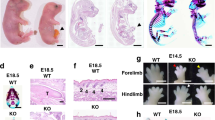Abstract
Crouzon syndrome is the result of a gain-of-function point mutation in FGFR2. Mimicking the human mutation, a mouse model of Crouzon syndrome (Fgfr2342Y) recapitulates patient deformities, including failed tracheal cartilage segmentation, resulting in a cartilaginous sleeve in the homozygous mutants. We found that the Fgfr2C342Y/C342Y mutants exhibited an increase in chondrocytes prior to segmentation. This increase is due at least in part to over proliferation. Genetic ablation of chondrocytes in the mutant led to restoration of segmentation in the lateral but not central portion of the trachea. These results suggest that in the Fgfr2C342Y/C342Y mutants, increased cartilage cell proliferation precedes and contributes to the disruption of cartilage segmentation in the developing trachea.
Similar content being viewed by others
References
Abler, L.L., Mehta, V., Keil, K.P., Joshi, P.S., Flucus, C.L., Hardin, H.A., Schmitz, C.T., and Vezina, C.M. (2011.) A high throughput in situ hybridization method to characterize mRNA expression patterns in the fetal mouse lower urogenital tract. J Vis Exp, doi: 10.3791/2912.
Apra, C., Collet, C., Arnaud, E., and Di Rocco, F. (2016). FGFR2 splice site mutations in Crouzon and Pfeiffer syndromes: two novel variants. Clin Genet 89, 746–748.
Cohen, M.M., and Kreiborg S. (1992). Birth prevalence studies of the Crouzon syndrome: comparison of direct and indirect methods. Clin Genet 41, 12–15.
Collet, C., Alessandri, J.L., Arnaud, E., Balu, M., Daire, V.C., and Di Rocco, F. (2014). Crouzon syndrome and Bent bone dysplasia associated with mutations at the same Tyr-381 residue in FGFR2 gene. Clin Genet 85, 598–599.
Eswarakumar, V.P., Horowitz, M.C., Locklin, R., Morriss-Kay, G.M., and Lonai, P. (2004). A gain-of-function mutation of Fgfr2c demonstrates the roles of this receptor variant in osteogenesis. Proc Natl Acad Sci USA 101, 12555–12560.
Eswarakumar, V.P., Ozcan, F., Lew, E.D., Bae, J.H., Tomé, F., Booth, C.J., Adams, D.J., Lax, I., and Schlessinger, J. (2006). Attenuation of signaling pathways stimulated by pathologically activated FGF-receptor 2 mutants prevents craniosynostosis. Proc Natl Acad Sci USA 103, 18603–18608.
Fan, J., Li, Y., Jia, R., and Fan, X. (2018). An inherited FGFR2 mutation increased osteogenesis gene expression and result in Crouzon syndrome. BMC Med Genet 19, 91.
Fenwick, A.L., Goos, J.A.C., Rankin, J., Lord, H., Lester, T., Hoogeboom, A.J.M., van den Ouweland, A.M.W., Wall, S.A., Mathijssen, I.M.J., and Wilkie, A.O.M. (2014). Apparently synonymous substitutions in FGFR2 affect splicing and result in mild Crouzon syndrome. BMC Med Genet 15, 95.
Gong, S.G. (2012). The Fgfr2 W290R mouse model of Crouzon syndrome. Childs Nerv Syst 28, 1495–1503.
Gothwal, S., Nayan, S., and Kumar, J. (2014). Crouzon syndrome with bony upper airway obstruction: case report and review literature. Fetal Pediatr Pathol 33, 199–201.
Ivanova, A., Signore, M., Caro, N., Greene, N.D.E., Copp, A.J., and Martinez-Barbera, J.P. (2005). In vivo genetic ablation by Cre-mediated expression of diphtheria toxin fragment. A. Genesis 43, 129–135.
Ke, R., Yang, X., Tianyi, C., Ge, M., Lei, J., and Mu, X. (2015). The C342R mutation in FGFR2 causes Crouzon syndrome with elbow deformity. J Craniofac Surg 26, 584–586.
Liu, J., Nam, H.K., Wang, E., and Hatch, N.E. (2013). Further analysis of the Crouzon mouse: effects of the FGFR2C342Y mutation are cranial bone-dependent. Calcif Tissue Int 92, 451–466.
Murakami, S., Kan, M., McKeehan, W.L., and de Crombrugghe, B. (2000). Up-regulation of the chondrogenic Sox9 gene by fibroblast growth factors is mediated by the mitogen-activated protein kinase pathway. Proc Natl Acad Sci USA 97, 1113–1118.
Ovchinnikov, D.A., Deng, J.M., Ogunrinu, G., and Behringer, R.R. (2000). Col2a1-directed expression of Cre recombinase in differentiating chondrocytes in transgenic mice. Genesis 26, 145–146.
Peskett, E., Kumar, S., Baird, W., Jaiswal, J., Li, M., Patel, P., Britto, J.A., and Pauws, E. (2017). Analysis of the Fgfr2C342Y mouse model shows condensation defects due to misregulation of Sox9 expression in prechondrocytic mesenchyme. Biol Open 6, 223–231.
Reardon, W., Winter, R.M., Rutland, P., Pulleyn, L.J., Jones, B.M., and Malcolm, S. (1994). Mutations in the fibroblast growth factor receptor 2 gene cause Crouzon syndrome. Nat Genet 8, 98–103.
Scheid, S.C., Spector, A.R., and Luft, J.D. (2002). Tracheal cartilaginous sleeve in Crouzon syndrome. Int J Pediatr Otorhinolaryngol 65, 147–152.
Snyder-Warwick, A.K., Perlyn, C.A., Pan, J., Yu, K., Zhang, L., and Ornitz, D.M. (2010). Analysis of a gain-of-function FGFR2 Crouzon mutation provides evidence of loss of function activity in the etiology of cleft palate. Proc Natl Acad Sci USA 107, 2515–2520.
Suh, Y.J., Bae, H.S., Choi, J.Y., Lee, J.H., Kim, M.J., Kim, S., Ryoo, H.M., and Baek, S.H. (2014). A novel FGFR2 mutation in tyrosine kinase II domain, L617F, in Crouzon syndrome. J Cell Biochem 115, 102–110.
Author information
Authors and Affiliations
Corresponding authors
Ethics declarations
Compliance and ethics The author(s) declare that they have no conflict of interest.
Rights and permissions
About this article
Cite this article
Hines, E.A., Jones, MK.N., Harvey, J.F. et al. Crouzon syndrome mouse model exhibits cartilage hyperproliferation and defective segmentation in the developing trachea. Sci. China Life Sci. 62, 1375–1380 (2019). https://doi.org/10.1007/s11427-019-9568-x
Received:
Accepted:
Published:
Issue Date:
DOI: https://doi.org/10.1007/s11427-019-9568-x




